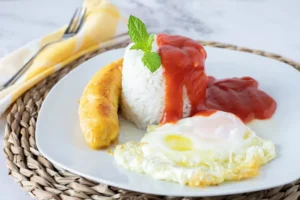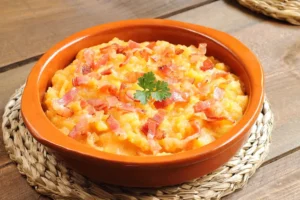Step into the vibrant world of Spanish cuisine. You’ll discover a treasure trove of flavors that reflect centuries of tradition and innovation. Among the delectable offerings that grace Spanish tables, migas stand as a shining example of culinary ingenuity. From its humble origins as a practical solution for using leftover bread to its diverse regional variations and time-honored cooking techniques. Migas has truly earned its place as a beloved staple in Spanish gastronomy. In this exploration, we embark on a journey through the fascinating history, delightful variations, expert tips, and enduring traditions that have shaped the essence of this iconic dish.
A Glimpse into History: The Birth of Migas
The story of migas begins in the sun-soaked Spanish countryside. Resourceful peasants and shepherds ingeniously transformed stale bread into a hearty and flavorful meal. The term “migas” itself translates to “crumbs,” a humble nod to its origins rooted in the prudent use of available ingredients. While its exact inception remains shrouded in the mists of time. Migas’ evolution from sustenance to culinary artistry is a testament to the creativity and resilience of Spanish cooks.
Diverse Variations: A Regional Tapestry of Flavors
As migas spread across Spain, they embraced the distinct culinary identities of various regions, resulting in a tapestry of flavorful variations. From the sun-drenched plains of Andalusia to the verdant landscapes of Galicia, migas underwent delightful transformations that celebrated local ingredients and traditions.
Andalusian Migas: In the southern region of Andalusia, migas are often paired with sardines. It creates a harmonious blend of textures and flavors that capture the essence of the Mediterranean coastline.
Castilian Migas: In the heart of Spain, the Castilian version of migas may feature chorizo, a flavorful sausage that infuses the dish with a smoky, savory note. This rendition exemplifies the art of balance. The spiciness of chorizo contrasts beautifully with the simple elegance of the migas base.
Crafting Authentic Spanish Migas: Expert Tips and Tricks
Stale Bread Matters: The foundation of exceptional migas lies in the choice of bread. Opt for a rustic or country-style loaf that has seen better days. Stale bread provides the ideal texture, absorbing flavors without becoming mushy.
The Sautéing Technique: Achieving migas perfection demands a skilled sautéing technique. Begin by crisping the bread to a delightful golden hue, infusing it with a satisfying crunch. Creating a central well in the pan for sautéing vegetables ensures an even distribution of flavors.
The Art of Seasoning: Paprika, whether smoked or sweet, is a key ingredient that imparts a distinctive hue and depth of flavor to migas. Season judiciously, allowing the paprika to enhance the overall taste profile without overpowering other ingredients. Experimenting with complementary seasonings such as cumin or red pepper flakes can elevate the dish even further.
Preserving Traditions: Spanish Migas in Modern Times
In a world characterized by rapid change, migas remain a steadfast reminder of culinary heritage. Families and communities continue to gather around tables, savoring the familiar comfort of migas prepared with love and care. Contemporary chefs embrace innovation. They do so with a deep respect for tradition, ensuring that the essence of migas endures for generations to come.
Spanish migas, are a culinary marvel born from necessity and nurtured by creativity. A testament to the enduring connection between food and culture. From its humble beginnings as a peasant’s delight to its current status as a cherished emblem of Spanish cuisine, migas embodies the spirit of innovation, adaptability, and the timeless pleasure of sharing a delicious meal. As we savor the diverse regional interpretations, masterful techniques, and rich history behind each bite, we honor the culinary legacy that has made Migas a true icon in the world of gastronomy.

Spanish Migas: Exploring the Rich Tradition
Ingredients
- ½-1 lb Stale bread preferably a rustic or country-style loaf
- 4-6 tbsp Olive oil
- 3-4 Cloves of garlic minced
- 1-2 Red or greenbell peppers chopped
- Chorizo sausage or bacon chopped (optional)
- Salt to taste
- Paprika to taste (smoked or sweet)
Instructions
- Prepare the Bread: Cut the stale bread into small cubes or tear it into rough pieces. The size can vary depending on your preference. Ideally, you want to use bread that's a bit dry or stale, as it will absorb the flavors and liquids without becoming mushy.
- Cook the Bread: In a large frying pan or skillet, heat 2-3 tablespoons of olive oil over medium-high heat. Add the bread cubes/pieces and cook, stirring frequently, until they become golden and crispy. This might take about 5-10 minutes. You can add more olive oil as needed to prevent sticking and ensure the bread becomes evenly crispy.
- Sauté Vegetables: Push the bread to the sides of the pan, creating a well in the center. Add the minced garlic, chopped bell peppers, and onion to the well. Sauté the vegetables until they become tender and slightly caramelized.
- Combine and Season: Mix the sautéed vegetables with the crispy bread in the pan. If you're using chorizo sausage or bacon, add it at this point and cook until it's heated through and slightly crispy. Season the mixture with salt and paprika to taste. You can also add other seasonings such as cumin or red pepper flakes for extra flavor
- Serve: Once everything is well mixed and heated through, transfer the migas to serving plates. You can serve migas as is or top it with fried eggs, grapes, orange slices, or fried peppers for added texture and flavor.
- Enjoy: Migas is often served as a hearty breakfast or brunch dish, but it can also be enjoyed as a side dish or even a main course.








